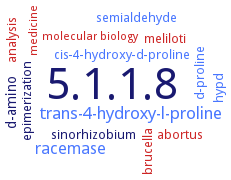5.1.1.8: 4-hydroxyproline epimerase
This is an abbreviated version!
For detailed information about 4-hydroxyproline epimerase, go to the full flat file.

Word Map on EC 5.1.1.8 
-
5.1.1.8
-
trans-4-hydroxy-l-proline
-
racemase
-
d-amino
-
brucella
-
sinorhizobium
-
abortus
-
d-proline
-
hypd
-
analysis
-
semialdehyde
-
epimerization
-
meliloti
-
cis-4-hydroxy-d-proline
-
medicine
-
molecular biology
- 5.1.1.8
- trans-4-hydroxy-l-proline
- racemase
-
d-amino
- brucella
-
sinorhizobium
- abortus
- d-proline
- hypd
- analysis
- semialdehyde
-
epimerization
- meliloti
- cis-4-hydroxy-d-proline
- medicine
- molecular biology
Reaction
Synonyms
4-hydroxyproline 2-epimerase, 4-hydroxyproline-2-epimerase, AbLhpA, BaHyPRE, Epimerase, hydroxyproline, FaProR, Hydroxyproline 2-epimerase, Hydroxyproline epimerase, HypE, HyPRE, L-Hydroxyproline epimerase, proline racemase/hydroxyproline epimerase, ProR/HypE, PrpA, Smb20268
ECTree
Advanced search results
Substrates Products
Substrates Products on EC 5.1.1.8 - 4-hydroxyproline epimerase
Please wait a moment until all data is loaded. This message will disappear when all data is loaded.
REACTION DIAGRAM
cis-4-hydroxy-D-proline
trans-4-hydroxy-L-proline
the reaction is completely bi-directional. The specific activity with cis-4-hydroxy-D-proline is 160% compared to the L-enantiomer. The bifunctional enzyme reversibly catalyzes the racemization of proline and the epimerization of 4-hydroxyproline and 3-hydroxyproline with similar kinetic constants. The catalytic efficiency (kcat/Km) values for L-proline and trans-4-hydroxy-D-proline are similar, whereas a preference for D-proline over cis-4-hydroxy-D-proline (45fold) is identified and is caused by a 75fold lower Km for D-proline. Catalysis is based on the same 1,1-proton transfer mechanism using two general acidic/basic cysteine residues located on opposite faces of the active site
-
-
r
cis-4-hydroxy-L-proline
trans-4-hydroxy-D-proline
the reaction is completely bi-directional. The specific activity with trans-4-hydroxy-D-proline is 97% compared to the L-enantiomer. The bifunctional enzyme reversibly catalyzes the racemization of proline and the epimerization of 4-hydroxyproline and 3-hydroxyproline with similar kinetic constants. Catalysis is based on the same 1,1-proton transfer mechanism using two general acidic/basic cysteine residues located on opposite faces of the active site
-
-
r
D-Ala
L-Ala
-
at 1-2% of the activity relative to allo-D-hydroxy-proline epimerization
-
?
L-azetidine-2-carboxylate
D-azetidine-2-carboxylate
low activity
-
-
?
Hydroxy-L-Pro
?
-
trans-hydroxy-L-Pro or cis-hydroxy-L-Pro, initial reaction of the pathway of hydroxyproline metabolism
-
-
?
Hydroxy-L-Pro
?
-
a mutant lacking the 4-hydroxyproline epimerase, the first enzyme of the pathway, is still equally active as an inducer of the remaining three enzymes, suggesting that each epimer has intrinsic inducer activity
-
-
?
trans-4-hydroxy-D-proline
cis-4-hydroxy-L-proline
the reaction is completely bi-directional. The specific activity with trans-4-hydroxy-D-proline is 97% compared to the L-enantiomer. The bifunctional enzyme reversibly catalyzes the racemization of proline and the epimerization of 4-hydroxyproline and 3-hydroxyproline with similar kinetic constants. Catalysis is based on the same 1,1-proton transfer mechanism using two general acidic/basic cysteine residues located on opposite faces of the active site
-
-
r
trans-4-hydroxy-D-proline
cis-4-hydroxy-L-proline
the reaction is completely bi-directional. The specific activity with trans-4-hydroxy-D-proline is 97% compared to the L-enantiomer. The bifunctional enzyme reversibly catalyzes the racemization of proline and the epimerization of 4-hydroxyproline and 3-hydroxyproline with similar kinetic constants. Catalysis is based on the same 1,1-proton transfer mechanism using two general acidic/basic cysteine residues located on opposite faces of the active site
-
-
r
cis-4-hydroxy-D-proline
no activity with L-proline
-
-
?
trans-4-hydroxy-L-proline
cis-4-hydroxy-D-proline
kcat/Km value for trans-4-hydroxy-L-proline is about 3fold lower than that for L-proline, which is attributed to a 17fold lower kcat value. The kinetic parameters of the epimerization of cis-4-hydroxy-D-proline can not be determined
-
-
r
trans-4-hydroxy-L-proline
cis-4-hydroxy-D-proline
the reaction is completely bi-directional. The specific activity with cis-4-hydroxy-D-proline is 160% compared to the L-enantiomer. The bifunctional enzyme reversibly catalyzes the racemization of proline and the epimerization of 4-hydroxyproline and 3-hydroxyproline with similar kinetic constants. The catalytic efficiency (kcat/Km) values for L-proline and trans-4-hydroxy-D-proline are similar, whereas a preference for D-proline over cis-4-hydroxy-D-proline (45fold) is identified and is caused by a 75fold lower Km for D-proline. Catalysis is based on the same 1,1-proton transfer mechanism using two general acidic/basic cysteine residues located on opposite faces of the active site
-
-
r


 results (
results ( results (
results ( top
top






